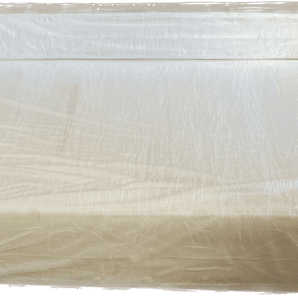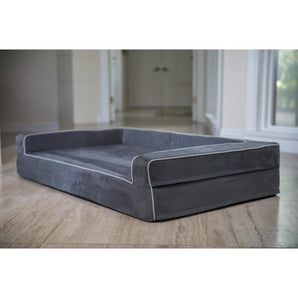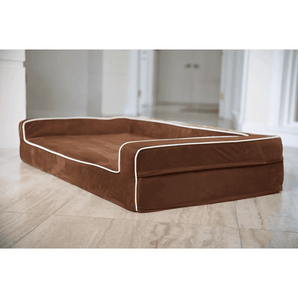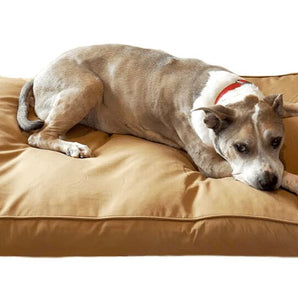Picking the perfect dog bed for your senior pup is a lot like choosing your own mattress. Some people need a super-firm bed for back support, while others want to sink into memory foam bliss. Just like us, our dogs have preferences and needs—and those needs change as they get older. For senior dogs, the right bed isn’t just about comfort; it’s about support, ease of access, and even improving their quality of life.
What to Look For in Senior Dog Beds

With so many options out there, choosing the best dog bed can feel overwhelming—but don’t worry. We'll help you zero in on the best beds for older dogs and what to look for when selecting the perfect bed so your furry friend gets plenty of restful sleep.
- Support: Senior dogs, especially large dogs and those with arthritis or joint pain, need extra support. Orthopedic and memory foam beds are excellent choices because they provide pressure relief and keep your pup’s spine and joints aligned.
- Comfort: Softness matters, but it’s not just about luxury. A comfortable bed can help your dog sleep better and improve their overall well-being. Look for high-quality materials that strike the perfect balance between cushion and support.
- Washable: Older dogs can sometimes have accidents. A bed with a removable, machine-washable waterproof cover is a lifesaver—both for your dog and for you.
- Style: Sure, your dog doesn’t care about design, but you probably do! Fortunately, there are plenty of stylish dog beds that will match your home decor while keeping your pup comfy and supported.
Special Considerations for Senior Dog Health Conditions
Senior dogs face unique challenges like joint pain, arthritis, and reduced mobility, so the bed they sleep on every day matters. Here’s how specific beds can help:
- Arthritis and Joint Pain: Memory foam and orthopedic dog beds provide the support needed to relieve pressure on sore joints. The high-density foam conforms to your dog’s body, reducing discomfort and ensuring their joints are properly cushioned. A supportive bed can also help prevent stiffness after a long nap, allowing your dog to move more comfortably throughout the day.
- Hip Dysplasia: Look for a supportive, low-profile bed that’s easy to get in and out of. Beds with bolsters or soft sides can provide extra security, while the low height ensures your pup doesn’t have to strain when getting up or lying down. This is especially important for dogs with limited mobility or weaker hind legs.
- Post-Surgery Recovery: Elevated beds or orthopedic options can help reduce strain on healing areas. An elevated bed minimizes the effort required to stand up, while orthopedic foam provides even weight distribution to avoid putting unnecessary pressure on sensitive spots. These beds can make recovery more comfortable and speed up the healing process.
- Incontinence: Waterproof beds with washable covers are essential for dogs prone to accidents. The waterproof lining prevents moisture from seeping into the foam, protecting the integrity of the bed. Additionally, a removable, machine-washable cover makes cleanup easy and stress-free, ensuring your pup always has a clean and odor-free place to rest.
Best Types of Dog Beds for Older Dogs

From orthopedic support to innovative infrared technology, here are the 7 best types of dog beds for older dogs:
1. Orthopedic Dog Bed
Orthopedic pet beds are specifically designed to provide extra support for aging dogs. These beds use high-density foam that conforms to your dog’s body, relieving pressure on sore joints and muscles. Orthopedic beds are particularly helpful for dogs with arthritis or hip dysplasia.
- Best For: Senior dogs with arthritis, joint pain, or mobility issues.
- Unique Features: Thick memory foam or high-density foam that distributes your dog's weight evenly and reduces pressure points.
2. Memory Foam Dog Bed
Memory foam dog beds are the ultimate dog bed when it comes to comfort. They mold to your dog’s body, providing customized support and cushioning for achy joints. Plus, the orthopedic memory foam helps keep your dog’s spine aligned while sleeping, which is crucial for older pups.
- Best For: Dogs who love plush comfort but still need solid support.
- Unique Features: Contouring memory foam that adapts to your dog’s body shape, weight and sleeping position.
Bolster Bed
Bolster dog beds come with raised sides or “bolsters” that provide extra support for your dog's head. These beds provide extra comfort and support while making your dog feel safe and secure. The bolsters can also help older dogs prop themselves up when getting in and out of the bed.
- Best For: Dogs who love to rest their head on a pillow or curl up against something.
- Unique Features: Raised sides for head and neck support, often paired with memory or orthopedic foam bases.
Elevated Dog Bed
Elevated dog beds sit off the ground, offering breathable support that keeps dogs cool and comfortable. They’re especially useful for dogs with joint pain because the elevated design reduces pressure when getting in and out of bed.
- Best For: Dogs in warm climates or those who need easy access to their bed.
- Unique Features: Raised design for better airflow, durable mesh or canvas material that’s easy to clean.
Infrared Dog Bed
Infrared dog beds use special technology to reflect your dog’s body heat back to them as infrared energy. This improves blood flow and reduces inflammation, making it ideal for older dogs with arthritis or chronic pain.
- Best For: Dogs with arthritis, inflammation, or reduced circulation.
- Unique Features: Infrared technology that promotes healing and relieves discomfort.
Waterproof Dog Bed
Accidents happen, especially with senior dogs. Waterproof dog beds are designed with a waterproof liner to protect the foam or filling inside. These beds are a game-changer for older dogs prone to incontinence.
- Best For: Dogs with incontinence issues or owners looking for easy-clean solutions.
- Unique Features: Water-resistant materials, removable and washable bed covers.
Custom Dog Bed
Sometimes your senior dog needs something truly tailored to their unique needs. Custom dog beds allow you to choose the size, materials, and support level to perfectly suit your dog’s condition and preferences.
- Best For: Dogs with very specific needs or unusual sleeping habits.
- Unique Features: Fully customizable options for size, foam density, and cover materials.
How to Choose the Right Size Dog Bed

When choosing a bed for your senior dog, size is just as important as support. A bed that’s too small won’t provide enough room to stretch out, while one that’s too large might not feel cozy. Measure your dog while they’re lying in their usual sleeping position, then add a few extra inches for comfort. If your dog likes to curl up, a bolster or round bed might be perfect. For dogs who sprawl, a rectangular memory foam or orthopedic bed works best.
Tips for Maintaining Dog Beds
Here are a few tips to ensure your dog's bed stays in top condition:
- Regular Washing: Remove and wash the cover every 1-2 weeks, or more often if accidents occur. If the bed doesn’t have a removable cover, spot-clean with pet-safe cleaners.
- Vacuum Frequently: Use a handheld vacuum to remove pet hair, dirt, and dander.
- Waterproof Liners: Consider a waterproof liner to protect the foam and prolong the bed’s life.
- Air It Out: Let the bed air out occasionally to prevent odors and moisture buildup.
How to Know You Need a New Dog Bed
As dogs age, their sleeping habits can change. Watch for these signs that your senior pup might need a more supportive bed:
- Restlessness: Pacing or frequently changing positions during the night.
- Avoiding Their Bed: Preferring hard floors or couches instead.
- Trouble Lying Down or Getting Up: Difficulty settling into a comfortable position.
- Excessive Licking or Chewing: Targeting sore joints or muscles.
If you notice any of these signs, it’s a good indicator that a new bed designed for comfort and support will help.
Frequently Asked Questions (FAQ)
How often should I replace my dog’s orthopedic bed?
Dog beds should generally be replaced every 3-5 years, depending on usage and the quality of the materials. If the foam begins to sag or lose its shape, it’s time for an upgrade.
What’s the difference between orthopedic and memory foam beds?
Orthopedic beds often use high-density foam for firm, even support. Memory foam beds contour to your dog’s body for a softer feel while still providing support.
How do I know if my senior dog is uncomfortable?
Signs include restlessness, difficulty getting up or lying down, and avoiding their bed altogether. Upgrading to a supportive bed can often make a noticeable difference.
Help Your Senior Dog Rest Comfortably
Your dog has spent their whole life by your side, and now it’s time to make their golden years as comfortable as possible. Choosing the right dog bed can help relieve pain, improve sleep, and support your furry friend where they need it most. Whether it’s an orthopedic bed for achy joints, a memory foam bed for extra cushioning, or a waterproof option for convenience, there’s a bed out there for your senior pup.
Check out Bully Beds for the perfect orthopedic dog bed and give your dog the gift of a good night’s rest—they’ve earned it!





